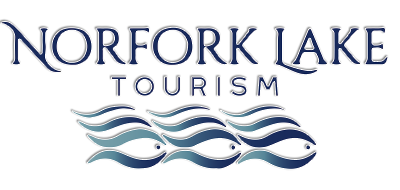
Perched on the east shore of Norfork Lake, at the old landing of the Highway 62 ferry, sits the little village of Henderson, AR. Principally it consists of a little post office and a boat dock at the Corp of Engineers recreation called of all things, Henderson. But, it was not always thus.
The original village of Henderson was located about one mile west of where it is today. Ironically, it was at the opposite landing of the highway ferry mentioned above. As settlers came into the beautiful, remote Ozark Mountains, they chose to make their homes in the narrow winding valleys. It was here that streams of sparkling, clear waters were found, and the only soil suitable for tilling was also in the valleys.

Shortly before the Civil War, really about 1860, the little settlement of Henderson was established. Along the writhing course of the North Fork River, the early arrivers made their homes. The small areas of level land were cleared, simple tools broke the soil, and they produced what food the needed. Before long, neighbors appeared in the valleys across the adjacent ridges. As their quality of living improved, their desire for more sophisticated staples and utensils increased. There was also a desire for closer association and communication with their neighbors. In this process of evolution, centers of communication became little villages. One of those was called Henderson.

It was located in a sheltered cove surrounded by heavily wooded hills. A small creek originated up in the hills to the west. The village was set where the creek made its way into the valley. About ¾ of a mile on the opposite side of the valley flowed the blue-green waters of the North Fork River.

One of the earliest settlers was Frank Smith. About 1902 he began operating a little ferry across the North Fork River. Frank died in the early 1930’s, and his sons, Paul, Check, Leffel, Claude, and Emmett, took over running the ferry. Local traffic was increasing, and primitive roads were reaching eastward across the Ozarks toward Mammoth Springs, Jonesboro, and Pocahontas as well as westward to Eureka Springs and Rodgers. This route finally developed into U.S. Highway 62.
In December of 1934, a concrete bridge was built across the North Fork River. The old Smith ferry died. 
Time marched on, and it was inevitable that progress came to the Ozarks. The US Army Corps of Engineers decided to put a “harness” on the rambunctious North Fork River and make it work for the good of the people.
Norfork Dam, with its electric generators, was built. And Norfork Lake began to rise. The buildings of the village of Henderson had to go. There were 3 or 4 homes, a small grocery store, and Leffel J. Smith’s general merchandise store, containing the U S Post Office. They were doomed.

The wide front porch of Leffel’s store was a fine place to “spit and whittle” on a lazy afternoon. There were gaping spaces between the wide, warped, wood floorboards, and some of those boards had some broken ends. There was a hodge-podge group of metal and cardboard signs nailed to the outside of the walls – there must have been a lot of snuff dippers in the area. Signs said there was a good supply of Bruton’s, Red Seal, Devoe, and Garrett’s snuff, especially the dental type. Vick’s Vatro-Nol and Vapo-Rub were available to relieve symptoms of head and chest colds, and miseries of ague. A large sign mounted on the front wall above the wrinkled sheet metal roof proclaimed that Peter Shoes, a solid leather footwear, were sold here.
Henderson Village was torn down. Lake waters are about 15 feet deep there now and a bit of Arkansas Ozark life is gone.

Henderson is now home to a hotel, a realtor office, a resort, a boat dealer, a ATV dealership, a few other small businesses, and two convenience stores.
The Henderson marina is now Lake Norfork Marina.
With the completion of the Memorial Bridges of Norfork Lake, the last voyage of US 62 and AR 101 car ferries, known locally as the Arkansas Navy, took place in 1984.

The concrete bridge that crossed the North Fork River still stands about 80 feet under the surface of Norfork Lake.

